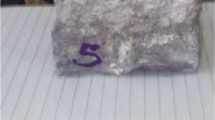Abstract
7075 Al–SiO2 composite foams were prepared by direct melt foaming method. The microstructures of the composite foams showed uniformly distributed particles in the composite foams. Aging studies showed that the hardness values of as-quenched composite foams were higher than that of 7075 Al foam and all the foam samples revealed two clear aging peaks. The aging behavior of the 7075 Al foam was different in kinetic and magnitude from of the 7075 Al–SiO2 composites, where the levels of peak hardness attained in the two peaks of 7075 Al foam were higher than those of the composite foams. Also, the aging times to attain the two peaks of the 7075 Al foam were shorter than those of the composite foams. DTA analyses indicated that the precipitation sequences of the composite foams were similar to that of the 7075 Al foam. However, the precipitation peaks of the composite foams were shifted to higher temperatures and the sizes of the hardening precipitate formation peaks in the composite foams were decreased, indicating that the formation of hardening precipitate zones was suppressed by the incorporation of the SiO2 particles or increasing the content of the foaming agent. The CTE of the 7075 Al foam was higher than that of the 7075 Al–15 vol % SiO2 composite foam.






Similar content being viewed by others
REFERENCES
Y. An, S. Yang, E. Zhao, Z. Wang, and H. Wu, “Fabrication of aluminum foam reinforced by graphene nanoflakes,” Mater. Lett. 212, 4–7 (2018).
I. Duarte, E. Ventura, S. Olhero, and J.M.F. Ferreira, “A new class of closed-cell aluminum foams reinforced with carbon nanotubes,” Cienc. Tecnol. Mater. 28, 5–8 (2016).
X. Liu, J. Zhang, Q. Fang, H. Wu, and Y. Zhang, “Response of closed-cell aluminum foams under static and impact loading: Experimental and mesoscopic numerical analysis,” Int. J. Impact Eng. 110, 382–394 (2016).
N. V. Ravi Kumar and A. A. Gokhale, “Role of temperature and SiCp parameters in stability and quality of Al-Si-Mg/SiC foams,” JOM 70, 823–828 (2018).
D. Lehmhus, J. Banhart, and M. Angel Rodriguez-Perez, “Adaptation of Aluminum Foam Properties by Means of Precipitation Hardening,” Mater. Sci. Technol. 18, 474–479 (2002).
K. C. Chan and S. H. Chan, “Effect of cell morphology and heat treatment on compressive properties of aluminum foams,” Mater. Manuf. Processes 19, 407–422 (2004).
Y. Feng, N. Tao, Z. Zhu, S. Hu, and Y. Pan, “Effect of aging treatment on the quasi-static and dynamic compressive properties of aluminum alloy foams,” Mater. Lett. 57, 4058–4063 (2003).
V. Rajput, D. P. Mondal, S. Das, N. Ramakrishnan, and A. K. Jha, “Effect of SiCp addition on age-hardening of aluminum composite and closed cell aluminum composite foam,” J. Mater. Sci. 42, 7408–7414 (2007).
M. Gu, Y. Jin, Z. Mei, Z. Wu, and R. Wu, “Effects of reinforcement oxidation on the mechanical properties of SiC particulate reinforced aluminum composites,” Mater. Sci. Eng., A 252, 188–198 (1998).
Z. Shi, S. Ochiai, M. Gu, M. Hojo and J. Lee, “The formation and thermostability of MgO and MgAl2O4 nanoparticles in oxidized SiC particle-reinforced Al–Mg composites,” Appl. Phys. A 74, 97–104 (2002).
Z. Luo, Y. Song and S. Zhang, “A TEM study of the microstructure of SiCp/Al composite prepared by pressureless infiltration method,” Scr. Mater. 45, 1183–1189 (2001).
V. Sreekumar, R. Pillai, B. Pai and M. Chakraborty, “Evolution of MgAl2O4 crystals in Al–MgSiO2 composites”, Appl. Phys. A 90, 745–752(2008).
R. M. Aikin Jr. and L. Christodoulou, “The role of equiaxed particles on the yield stress of composites”, Scr. Metall. Mater. 2, 9–14 (1991).
M. Taya, K. E. Lulay, and D. J. Lloyd, “Strengthening of a particulate metal matrix composite by quenching,” Acta Metall. Mater. 39, 73–87 (1991).
W. S. Miller and F. J. Humphreys, “Strengthening mechanisms in particulate metal matrix composites,” Scr. Metall. Mater. 25, 33–38 (1991).
M. Haesche, D. Lehmhus, J. Weise, M. Wichmann, I. Cristina, and M. Mocellin,” Carbonates as foaming agent in chip-based aluminum foam precursor,” J. Mater. Sci. Tecnol. 26, 845–850 (2010).
E. Donoso, “Calorimetric study of the dissolution of Guinier–Preston zones and η′ phase in Al–4.5 at % Zn–1.75 at % Mg”, Mater. Sci. Eng. 7, 39–46(1985)
G. Sha and A, Cerezo, “Early-stage precipitation in Al–Zn–Mg–Cu alloy (7050),” Acta Mater. 52, 4503–4516 (2004).
P. Bardhan and E. A. Starke, “Preprecipitation in Al/Zn/Mg alloys studied by hardness and small-angle X-ray scattering measurements,” J. Mater. Sci. 3, 577–583 (1968).
R. Karunanithi, K. S. Ghosh, and S. Bera “Synthesis and characterization of TiO2 dispersed Al 7075 micro- and nanocomposite,” Adv. Mater. Res. 984–985, 313–318 (2014).
A. V. Pozdniakov, A. Lotfy, A. Qadir, E. Shalaby, M. G. Khomutov, A. Yu. Churyumov, and V. S. Zolotorevskiy, “Development of Al–5Cu/B4C composites with low coefficient of thermal expansion for automotive application,” Mater. Sci. Eng., A 688, 1–8 (2017).
Z. Trojanová, Z. Drozd, P. Minárik, P. Lukác, and A. Kasakewitsch, “Influence of texture on the thermal expansion coefficient of Mg/BN nanocomposite,” Thermochim. Acta 644, 69–75 (2016).
Z. Lei, K. Zhao, Y. Wang, and L. An, “Thermal expansion of Al matrix composites reinforced with hybrid micro-/nano-sized Al2O3 particles,” J. Mater. Sci. Technol. 3, 61–64 (2014).
Funding
This project was supported financially by the Science and Technology Development Fund (STDF), Egypt, Grant no. 25243.
Author information
Authors and Affiliations
Corresponding author
Rights and permissions
About this article
Cite this article
Daoud, A., Abou El-Khair, M.T., Fairouz, F. et al. Microstructures, Aging Behavior and Thermal Expansion of 7075 Al–Silica Particle Waste Composite Foams Produced with Recycled Aluminum Cans. Phys. Metals Metallogr. 121, 1358–1363 (2020). https://doi.org/10.1134/S0031918X20130049
Received:
Revised:
Accepted:
Published:
Issue Date:
DOI: https://doi.org/10.1134/S0031918X20130049




